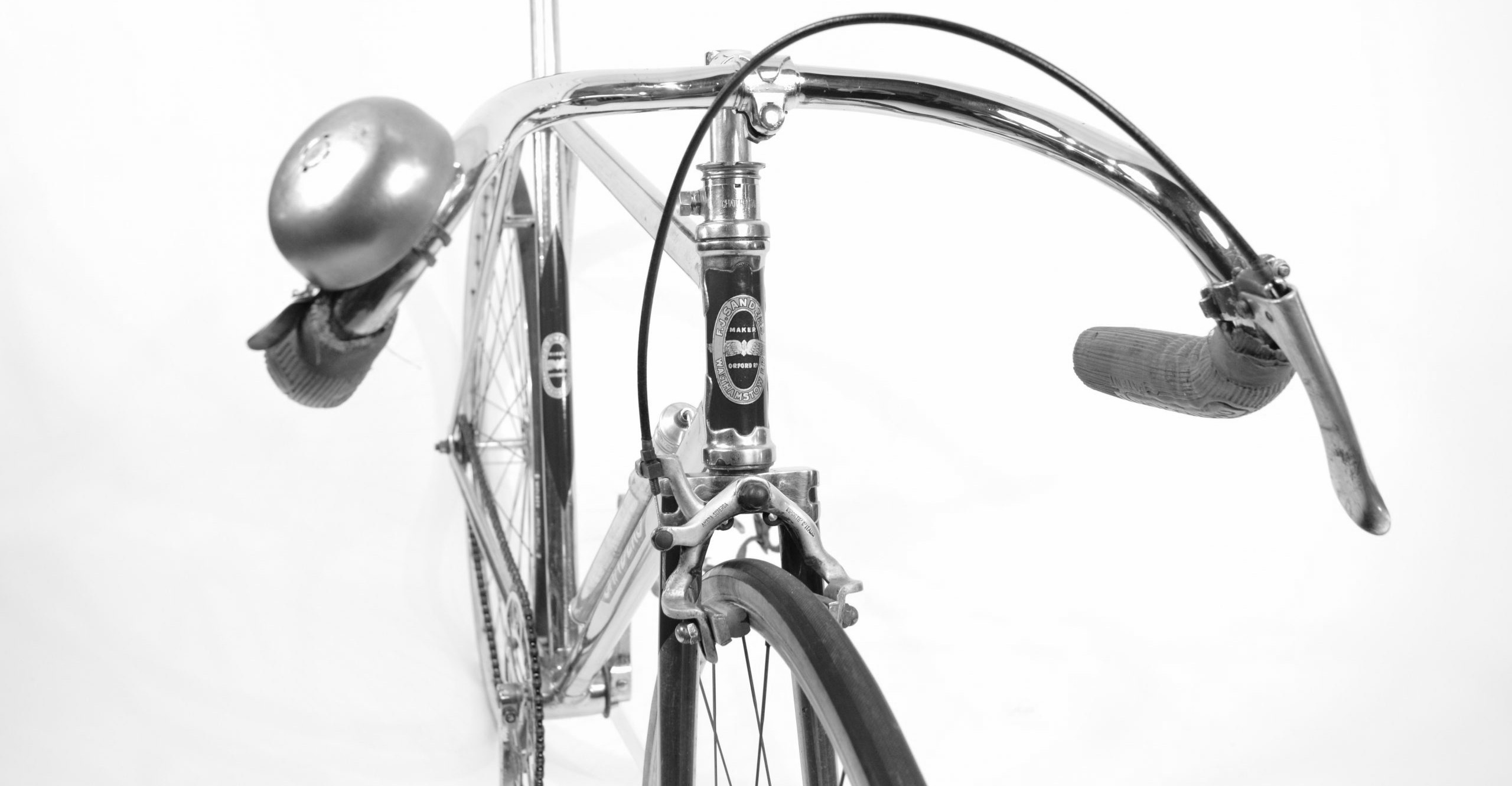Pedalling Puritans: The amateur in the history of competitive cycling
Posted: Sunday 16th August 2020
Amateur one who engages in sport purely for pleasure (opp. to professional) (Chambers Concise Dictionary, p.27)
The ‘amateur’ in cycle sport is today officially as dead as the dodo. True, the vast majority of modern sporting cyclists perforce remain amateurs in the above sense, but at the higher levels of the sport the amateur is now as rare as the proverbial hens’ teeth. One way or another, elite competitors in the modern era are invariably sponsored cyclists.
The demise of the official amateur/professional distinction in competitive cycling dates from the early 1990s when, following the Barcelona Olympic Games of 1992, the IOC finally abandoned its recognition of these as being distinct categories. Many sporting codes, including competitive cycling, immediately followed suit. However, the disappearance of the officially–recognised amateur cyclist was much more than simply a change to a set of bureaucratic rules. Rather, it was a decision to jettison a competitive way of life which had been variously championed, challenged, defended and disputed within the sport for a period of more than a century, beginning in the late 1800s.
In essence, ‘amateurism’ consisted of practices, customs, traditions, principles, beliefs and values which combined to profoundly influence the development of competitive cycling from its early beginnings onwards.
The amateur ideal in the early days of international cycle sport.
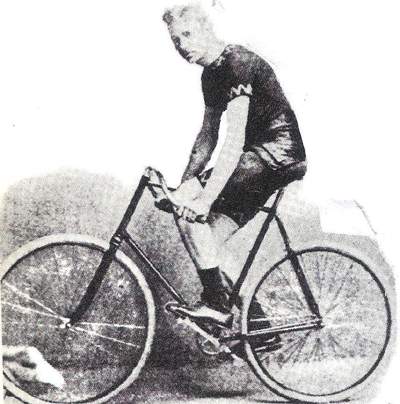
Amateurism figured prominently at the very outset of the sport’s internationalisation. From meetings first held in 1892, the International Cycling Association (ICA) was formed by representatives of the national cycling associations of the UK (which had pioneered the move), Belgium, Canada, Denmark, France, Germany, Holland, Italy, and the United States. In terms of the constitution adopted by the new association, not only were its approved competitors to be exclusively amateur but all its elected office bearers and officials were to be purely ‘honorary’ (i.e. unpaid and voluntary). This accorded with amateur sporting ideals then widely current, most notably in Britain. Not surprisingly it was an Englishman, Henry Sturmey (subsequently famous for the ‘Sturmey–Archer’ hub gear), who was elected the first honorary president of the ICA with its headquarters in London.
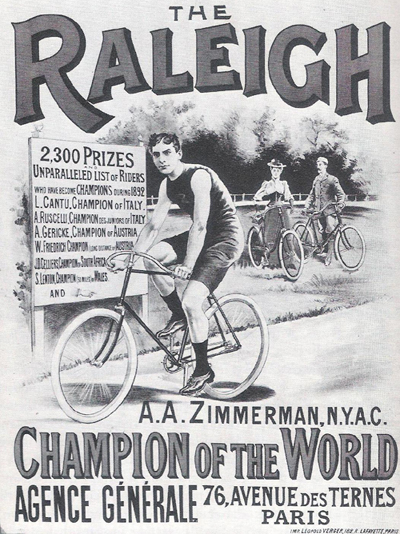
The newly formed ICA immediately dedicated itself to promoting official annual world cycling championships restricted to amateur competitors. The organisation defined an amateur as:
‘One who has never engaged in, not assisted in, nor taught any athletic exercise for money, nor knowingly competed with or against a professional for a prize of any description… or who is recognised as an amateur by the ruling body of his [sic] country.’ (ICA, 1892. Rules for the conduct of the amateur cycling championships of the world. London)
The first ICA world championships were planned for 1893 to be held in Chicago USA to coincide with that city’s World Fair. Three title events were to be contested by amateurs on the Chicago track: the 1 mile sprint, a 10 mile bunch race and a 100 Km. tandem–paced stayers’ event.
However, a furore arose when the ICA hierarchy promptly excluded Italian amateur cyclists from competing in these inaugural world championships for infringing its amateur rules. The Italian riders had allegedly sold cycling trophies and medals they had won for cash. Despite appeals by representatives of Italian cycling, the ban was upheld. This immediately created dissension within the ranks of the fledgling ICA, with the Italians blaming the organisation’s puritanical ‘British oligarchy’ for the debacle. However, further conflicts were soon to follow within the ICA over the issue of amateurism.
A.A. Zimmerman and the Raleigh connection
The ICA’s first amateur world one mile and ten mile championships in 1893 were both won by the United States’ Arthur Augustus Zimmerman of Newark, New Jersey, colloquially known as ‘Zimmy’. The 100 Km. stayers’ title winner was a South African, Laurens Meintjies, in 2hrs. 46.12 mins. – an average speed of 36 Kph. Zimmy was immediately feted as a cycling superstar and proceeded to accept sponsorship from Raleigh cycles, appearance money from promoters and valuable racing prizes. This brought him into immediate conflict with the ICA authorities who were determined to uphold the amateur ideal. Zimmerman responded by promptly turning professional and is reputed to have subsequently earned as much as US$ 40 000 annually.
In 1895, in which year the championships were held in Cologne, Germany, the ICA suddenly changed its mind and introduced annual professional sprint and paced distance world titles to match their amateur counterparts. Why this volte-face? Presumably the burgeoning professional class forced its hand and this step allowed the ICA to maintain the amateur ideal while simultaneously assuming overall control of cycle sport.
In 1896 the ICA received an unexpected moral boost for its stand on amateurism from the inaugural modern Olympic Games in Athens, Greece. These explicitly adopted the amateur ideal after their founder, Baron de Coubertin, had been impressed by its character–building potential after visiting Rugby public school in England. These first Olympics were thus confined to amateur competitors including cyclists, with Masson of France winning the two track titles (the sprint and 2000 metre time trial) and his compatriot Flamand winning the road race. Even so, the ICA found itself unable to contain internal conflicts in which disputes over the definition of amateurism figured prominently. Finally, in 1900, the ICA’s control of world cycling affairs reached breaking point.
The collapse of the ICA and the creation of the UCI. In 1900, the ICA planned to stage its world championships in Paris which would be the first time that these were held in France. However, like the Italians, French cycling had grievances with the British–dominated ICA by virtue of its inclusion of separate representatives from England, Wales, Scotland and Ireland. This was seen as giving the United Kingdom undue influence in international cycling affairs which in effect amounted to veto powers on matters such as the rules concerning amateurism.
It proved an opportune moment for the critics to challenge the ICA. Following a confrontational meeting, the dissidents headed by France and Italy decided to secede from the ICA and form a rival body, the Union Cyclisme Internationale (UCI). Its founders were France, Italy, Belgium, Switzerland and the United States. At a stroke, therefore, the international authority of the ICA was undermined. The UCI then assumed responsibility for organising the 1900 world championships in Paris. The amateur/professional distinction was retained as were the title events – sprint and paced – previously contested under the ICA. The UCI introduced the awarding of ‘rainbow jerseys’ to their new world champions who were:
- Amateur sprint: Dominique Nauts (Belgium)
- Professional sprint: Edmond Jacquelin (France)
- Amateur paced: Corterenzo Huret (France)
- Professional paced: Louis Bastien (France)
At the same time the UCI barred entry for a period of three years to those cycling nations which had declined to join it at the outset. It was thus only in 1903 that Britain’s NCU alone amongst the United Kingdom’s ‘home’ cycling bodies was allowed to affiliate directly to the UCI. It belatedly did so, thereby rendering those of Britain’s cyclists who were NCU members eligible to contest UCI world titles for the first time. Thus the substantial British influence on the politics and policies of international cycle sport which had existed previously under the ICA (disbanded in 1902) was significantly reduced.
Amateurism and the 20th century ‘British way’ of cycle sport
‘I fought a chap on the stage of the Crown Theatre in Brighton. Because I was an amateur cyclist I couldn’t take the £5 purse. I was promised a gold medal if I won. I am still waiting for it. And that was in 1909!’
Wally McLaren (Brighton Mitre C.C. member and boxer reminiscing on the occasion of his 90th birthday in 1979).
In the 44 years between 1903 and 1947, British cyclists won a total of 17 UCI world titles. However, all were in the amateur division and, with the exception of one on the road in 1922 (a TT won by Dave Marsh), all were in track events. Moreover, 14 of these 17 wins came before WWI. In the 25 year period between 1922 and 1947, no British cyclist won a UCI world title. Furthermore, it was only in 1949, after WWII, that a UCI professional world title was won for the first time by a British cyclist when Reg Harris took the professional sprint ‘rainbow jersey’. The last occasion in this time–frame that an Olympic cycling gold medal went to Britain was in the track tandem sprint event in 1920.
Taken together, these statistics point to two leading characteristics of British cycle sport during the first half of the 20th century:
Firstly, that it remained firmly wedded to the amateur ideal;
Secondly, that it existed largely outside the mainstream of international competitive cycling, especially in the interwar period.
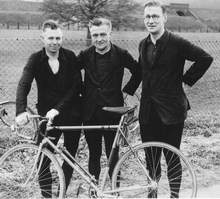
Nevertheless, this period is regarded as the ‘golden age of cycling’ in Britain. It was an era during which amateur cycling clubs proliferated and flourished throughout the country, fostering mass participation both as a competitive sport and as a pastime. Closely associated with this was the development of the uniquely British sport of amateur road time trialling at fixed distances of 10, 25, 50 and 100-miles and also 12 and 24-hours. Administered separately from amateur track racing which was the preserve of the NCU, road time trialling in Britain went from strength to strength over this period.
But while strictly amateur cycle sport may have publicly appeared to flourish in Britain during the first half of the 20th century, there was another side to it. Tales abound about the ruses and ploys used to circumvent the British cycling Establishment’s rigid adherence to the amateur ideal:
- Leading riders often became nominal employees of lightweight manufacturers
- Race promoters surreptitiously paid star riders appearance money
- Lightweight frame builders devised trademark models, finishes, tubing shapes and hand–cut lug patterns to serve as mute advertisements of their craftsmanship
- Valuable silver and gold trophies were available to be won outright by amateur riders
However, it took the post–WWII combination of the British League of Racing Cyclists’ (BLRC) mass–start road racing revolution and the charismatic Reg Harris turning professional to finally undermine British cycling’s puritanical amateur lobby. But even as this seemingly last bastion of amateurism in the cycling world was crumbling, support for amateur cycle sport came from a new and totally unexpected source: the Soviet Union and several of its Eastern Bloc allies – East Germany, Poland, and Czechoslovakia
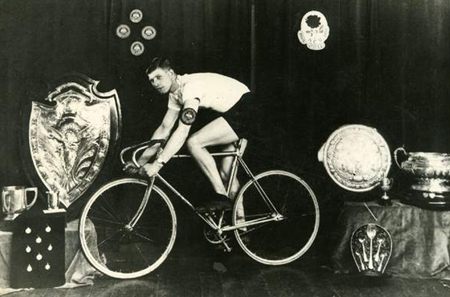
From Russia with love: the era of the champion ‘shamateur’ cyclist
Shamateur a sports player who makes money from sporting activities though classed as an amateur.
(Concise OED, p.1272)
‘ British amateurs were expected to compete against Eastern Bloc amateurs who trained like pros under the cover story that they were in the military.’ (‘British Legends: Steve Joughlin, Pocket rocket’, Cycling Weekly Dec. 9, 2010, p.32)
With the advent of the Cold War in the early 1950s, the Iron Curtain countries saw propaganda value for their political systems as lying in sporting successes. Competitive cycling, and specifically its amateur variant which accorded with their anti–capitalist ideology, was identified as one of several sports which could be profitably exploited to this end. On the road, the (East) Berlin – Warsaw – Prague Peace Race (famously won by the Scot, Ian Steel, in 1952 riding as an independent for ‘Viking’) became the flagship stage racing event. On the track, the Eastern Europeans focused on the amateur events for which UCI world titles and Olympic medals were available. State–sponsored sports academies were established and state–sponsored amateurs who trained and raced on a fulltime basis became the norm.
Successes soon followed. By 1972, the Soviet Union had won 33 and East Germany 8 UCI amateur gold medals at world championships. At the 1972 Munich Olympics, Russia won the tandem event on the track and the 4–man road time trial. International successes became the norm for the amateur cyclists from the Eastern bloc. But, as cyclists and other sportspeople elsewhere became familiar with the state–sponsored setup which produced a seemingly endless stream of champions, the term ‘shamateur’ was coined to describe them.
Paralleling these developments in amateur competitive cycling were changes in the organisation of the administration of international cycling. East European ‘apparatchiks’ were elected to influential administrative positions in world sport. The UCI, apparently in response to pressure from the Olympic movement, restructured in the mid 1960s. The UCI became an umbrella body with two independent subdivisions: the amateur FIAC and the FICP responsible for professionals.
At its height, the FIAC had 127 member nations but was dominated administratively by representatives from the Eastern bloc. They were thus able to critically shape amateur cycle sport globally, deciding on championship events, championship venues, racing rules and longer–term amateur policies. However, the collapse of the Berlin Wall and the rapid demise of the Eastern bloc system which followed precipitated a ‘house of cards’ situation in which the amateurism in cycle sport it had supported totally disintegrated. As Fotheringham (2010:124) notes: ‘The sudden collapse of the Berlin Wall in 1989 left sports centres across Eastern Europe short of money, and a vast number of talented amateurs came on the market: they flooded into cycling.’
Less obviously, a varied assortment of cycling coaches, administrators, officials, mechanics, team managers, masseurs, soigneurs, specialists in sports medicine and ‘gofors’ from these countries also appeared on the free market. Their subsequent influence on modern post–amateur competitive cycling with regard to such matters as the use of sophisticated performance–enhancing drugs has yet to be assessed.
With the collapse of the Eastern bloc, however, amateur cycle sport’s final raison d’être disappeared. In short order the UCI disbanded both the FIAC and the FICP and abandoned the amateur/professional distinction. By the mid 1990s, amateurism in cycle sport had thus been officially consigned to the ‘dustbin of history’.
References and sources
This article is based on a wide variety of printed and internet sources. The following have been of particular value:
Fotheringham, W. (2010). Cyclopedia:it’s all about the bike. London: Yellow Jersey Press.
Henderson, N.G. (1973). Cycling Classics, 1970-1972. London: Pelham.
www.classiclightweights.co.uk
Posted: Sunday 16th August 2020
This article appears in the following categories.
Upcoming Events
Whether you are looking for a gentle social meet up, or a 100-mile ride browse the community’s upcoming events and plan your next weekend outing.
